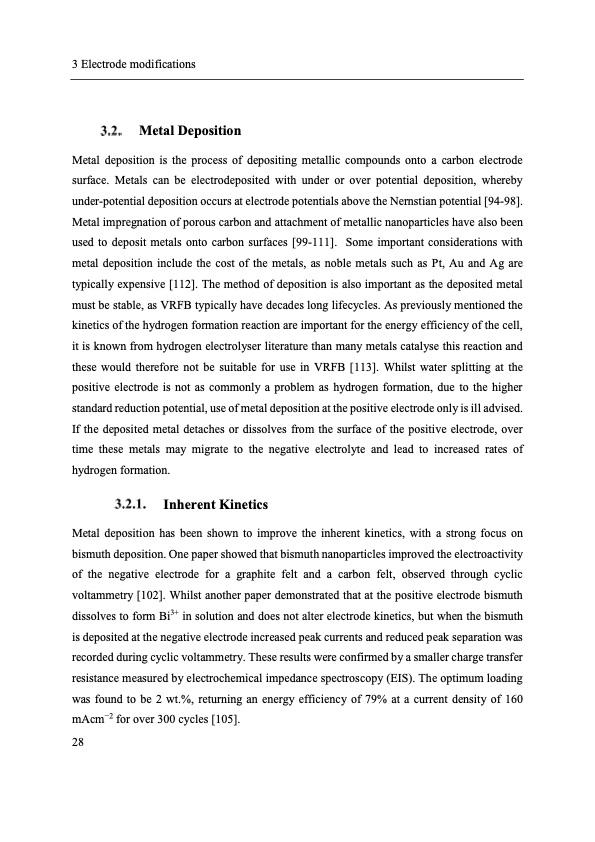
PDF Publication Title:
Text from PDF Page: 040
3 Electrode modifications Metal Deposition Metal deposition is the process of depositing metallic compounds onto a carbon electrode surface. Metals can be electrodeposited with under or over potential deposition, whereby under-potential deposition occurs at electrode potentials above the Nernstian potential [94-98]. Metal impregnation of porous carbon and attachment of metallic nanoparticles have also been used to deposit metals onto carbon surfaces [99-111]. Some important considerations with metal deposition include the cost of the metals, as noble metals such as Pt, Au and Ag are typically expensive [112]. The method of deposition is also important as the deposited metal must be stable, as VRFB typically have decades long lifecycles. As previously mentioned the kinetics of the hydrogen formation reaction are important for the energy efficiency of the cell, it is known from hydrogen electrolyser literature than many metals catalyse this reaction and these would therefore not be suitable for use in VRFB [113]. Whilst water splitting at the positive electrode is not as commonly a problem as hydrogen formation, due to the higher standard reduction potential, use of metal deposition at the positive electrode only is ill advised. If the deposited metal detaches or dissolves from the surface of the positive electrode, over time these metals may migrate to the negative electrolyte and lead to increased rates of hydrogen formation. Inherent Kinetics Metal deposition has been shown to improve the inherent kinetics, with a strong focus on bismuth deposition. One paper showed that bismuth nanoparticles improved the electroactivity of the negative electrode for a graphite felt and a carbon felt, observed through cyclic voltammetry [102]. Whilst another paper demonstrated that at the positive electrode bismuth dissolves to form Bi3+ in solution and does not alter electrode kinetics, but when the bismuth is deposited at the negative electrode increased peak currents and reduced peak separation was recorded during cyclic voltammetry. These results were confirmed by a smaller charge transfer resistance measured by electrochemical impedance spectroscopy (EIS). The optimum loading was found to be 2 wt.%, returning an energy efficiency of 79% at a current density of 160 mAcm−2 for over 300 cycles [105]. 28PDF Image | Electron Transfer Kinetics in Redox Flow Batteries

PDF Search Title:
Electron Transfer Kinetics in Redox Flow BatteriesOriginal File Name Searched:
electron-transfer-flow-batteries-thesis.pdfDIY PDF Search: Google It | Yahoo | Bing
Salgenx Redox Flow Battery Technology: Salt water flow battery technology with low cost and great energy density that can be used for power storage and thermal storage. Let us de-risk your production using our license. Our aqueous flow battery is less cost than Tesla Megapack and available faster. Redox flow battery. No membrane needed like with Vanadium, or Bromine. Salgenx flow battery
| CONTACT TEL: 608-238-6001 Email: greg@salgenx.com | RSS | AMP |